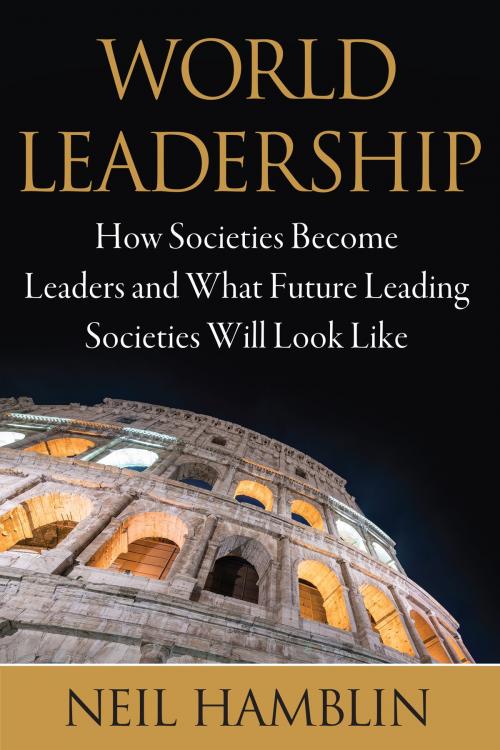World Leadership: How Societies Become Leaders and What Future Leading Societies Will Look Like
Nonfiction, Social & Cultural Studies, Political Science, International, Foreign Legal Systems, History, World History| Author: | Neil Hamblin | ISBN: | 9780999238806 |
| Publisher: | Neil Hamblin | Publication: | November 26, 2017 |
| Imprint: | Smashwords Edition | Language: | English |
| Author: | Neil Hamblin |
| ISBN: | 9780999238806 |
| Publisher: | Neil Hamblin |
| Publication: | November 26, 2017 |
| Imprint: | Smashwords Edition |
| Language: | English |
The United States is the dominant world power today, but that has not always been the case, and may not always be the case. Great Britain, Rome, and ancient Sumer were once leaders in their own time, but their empires dissolved into history. Understanding how a leader emerges is critical to understanding how our world works because it turns out that the competition to be the leader has been the primary driver of human social progress. World Leadership provides a framework for understanding how leadership is developed, not by an individual, but by a society.
World Leadership surveys history to identify the three ways societies acquired leadership in the past—jump to a new societal level first, acquire a new dominating innovation first, or manage the four leadership power sources better than rivals. Societal levels are the stages of human civilization—bands, tribes, chiefdoms, fiefdoms, and nation-states; whichever society jumped to a higher level first became the leader. Changes in societal level, and leadership power in general, is generated by transformative innovations. Only fourteen such innovations have ever existed, and they work in different ways. Some changed the way resources are managed. Others changed the environment. Some gave a society dominance through military strength and wealth. Whenever a society embraced these innovations early, it gained leadership power and influence over rivals.
Understanding how leadership develops is imperative now because the world is changing. New transformative innovations have arrived and by the end of this century, the world will likely be transitioning to its next societal level, the nation-union. The society that prepares for this now will be best positioned for leadership in the next century. Understanding leadership also unlocks mysteries about our contemporary world such as why nation-building efforts tend to fail and why the best hope for U.S. disengagement from Afghanistan may rest in restoring its monarchy.
Part I of World Leadership surveys history to craft the leadership framework. It examines powerful societies, from antiquity to modern times, to understand the common threads of what made them into leaders. Part II uses this framework to project forward in time. It reveals which regions have a head-start on becoming future world leaders. Part III applies this framework to some of today’s thornier problems, particularly those in the Middle East. It also advises societies where to invest if they desire a leadership role in the future. The book ends by reexamining society in light of this understanding and challenging us to become the kind of society worthy of a leadership role.
The United States is the dominant world power today, but that has not always been the case, and may not always be the case. Great Britain, Rome, and ancient Sumer were once leaders in their own time, but their empires dissolved into history. Understanding how a leader emerges is critical to understanding how our world works because it turns out that the competition to be the leader has been the primary driver of human social progress. World Leadership provides a framework for understanding how leadership is developed, not by an individual, but by a society.
World Leadership surveys history to identify the three ways societies acquired leadership in the past—jump to a new societal level first, acquire a new dominating innovation first, or manage the four leadership power sources better than rivals. Societal levels are the stages of human civilization—bands, tribes, chiefdoms, fiefdoms, and nation-states; whichever society jumped to a higher level first became the leader. Changes in societal level, and leadership power in general, is generated by transformative innovations. Only fourteen such innovations have ever existed, and they work in different ways. Some changed the way resources are managed. Others changed the environment. Some gave a society dominance through military strength and wealth. Whenever a society embraced these innovations early, it gained leadership power and influence over rivals.
Understanding how leadership develops is imperative now because the world is changing. New transformative innovations have arrived and by the end of this century, the world will likely be transitioning to its next societal level, the nation-union. The society that prepares for this now will be best positioned for leadership in the next century. Understanding leadership also unlocks mysteries about our contemporary world such as why nation-building efforts tend to fail and why the best hope for U.S. disengagement from Afghanistan may rest in restoring its monarchy.
Part I of World Leadership surveys history to craft the leadership framework. It examines powerful societies, from antiquity to modern times, to understand the common threads of what made them into leaders. Part II uses this framework to project forward in time. It reveals which regions have a head-start on becoming future world leaders. Part III applies this framework to some of today’s thornier problems, particularly those in the Middle East. It also advises societies where to invest if they desire a leadership role in the future. The book ends by reexamining society in light of this understanding and challenging us to become the kind of society worthy of a leadership role.















